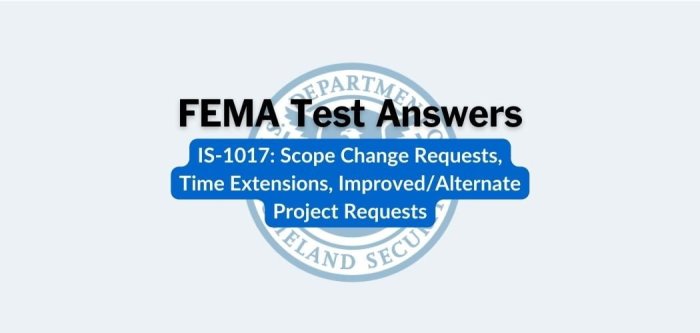The FEMA IS-800-D final exam answers are the culmination of a comprehensive study of emergency management principles and practices. This exam is designed to assess candidates’ understanding of the core concepts and principles covered in the FEMA IS-800-D course, ensuring their readiness for roles in emergency management and response.
The FEMA IS-800-D final exam covers a wide range of topics, including emergency management functions, the Incident Command System (ICS), the National Incident Management System (NIMS), hazard mitigation, public information and communication, planning and preparedness, incident management, and recovery and long-term recovery.
By thoroughly preparing for this exam, candidates can demonstrate their proficiency in these critical areas and enhance their ability to contribute effectively to emergency management efforts.
FEMA IS-800-D Final Exam Overview

The FEMA IS-800-D final exam is a comprehensive assessment of knowledge and skills acquired through the Incident Command System (ICS) training program.
The exam consists of 100 multiple-choice questions covering all aspects of ICS, including incident management, planning, operations, and logistics. Candidates have 120 minutes to complete the exam, and a passing score of 75% is required.
Exam Format
The exam is divided into five sections, each covering a specific area of ICS:
- Section 1: Introduction to ICS (10 questions)
- Section 2: Incident Management (20 questions)
- Section 3: Planning (20 questions)
- Section 4: Operations (20 questions)
- Section 5: Logistics (30 questions)
Core Concepts and Principles

The FEMA IS-800-D course provides a comprehensive overview of the National Incident Management System (NIMS), a framework for coordinating and managing incidents across multiple jurisdictions and agencies. The course covers key principles and concepts essential for effective incident management, including the Incident Command System (ICS), multi-agency coordination, and resource management.
The FEMA IS-800-D Final Exam assesses candidates’ understanding of these core concepts through various sections:
Incident Command System (ICS)
- Principles and structure of ICS
- Roles and responsibilities of ICS personnel
- Incident Action Planning
- Resource management within ICS
Multi-Agency Coordination
- Principles of multi-agency collaboration
- Establishing and maintaining interagency relationships
- Effective communication and coordination mechanisms
- Incident management teams and joint information systems
Resource Management
- Types and sources of resources
- Resource acquisition and allocation
- Resource tracking and accountability
- Demobilization and resource release
Emergency Management Functions

Emergency management functions are the primary responsibilities of emergency managers and agencies. These functions provide a framework for coordinating and managing emergency response and recovery efforts.
Prevention
Prevention involves taking steps to reduce the likelihood of an emergency or disaster occurring. Examples include public education campaigns, hazard mapping, and building codes.
Protection
Protection measures aim to minimize the impact of an emergency or disaster. This includes actions such as evacuation, sheltering, and warning systems.
Mitigation
Mitigation involves reducing the vulnerability of communities to emergencies and disasters. Examples include strengthening infrastructure, land-use planning, and hazard mitigation grants.
Response
Response involves the immediate actions taken during an emergency or disaster. This includes search and rescue operations, providing medical care, and coordinating relief efforts.
Recovery
Recovery focuses on restoring communities and infrastructure to pre-disaster conditions. This includes rebuilding homes and businesses, providing financial assistance, and supporting community recovery efforts.
Exam Testing
The FEMA IS-800-D Final Exam tests candidates’ understanding of emergency management functions through questions that assess their ability to:
- Identify the key components of each function.
- Explain how the functions work together.
- Apply the functions to real-world emergency scenarios.
Incident Command System (ICS): Fema Is-800-d Final Exam Answers
The Incident Command System (ICS) is a standardized, on-scene emergency management system that provides a common framework for coordinating and managing resources during an incident. ICS is designed to be flexible and scalable, and can be used to manage incidents of all sizes and complexities.The
ICS structure is based on a hierarchical command structure, with a single Incident Commander (IC) who is responsible for overall incident management. The IC is supported by a staff of Section Chiefs, who are responsible for specific functional areas of the incident, such as operations, planning, logistics, and finance/administration.The
ICS principles are based on the following concepts:
Unity of command
There is a single Incident Commander who has overall authority and responsibility for the incident.
Span of control
The number of subordinates that a supervisor can effectively manage is limited.
Common terminology
All personnel involved in the incident use the same terminology and procedures.
Flexibility
ICS can be tailored to the specific needs of the incident.
Scalability
ICS can be scaled up or down to meet the changing needs of the incident.ICS is integrated into the FEMA IS-800-D final exam in a number of ways. The exam includes questions on the ICS structure, principles, and use. Additionally, the exam requires candidates to apply ICS principles to real-world incident scenarios.
National Incident Management System (NIMS)
The National Incident Management System (NIMS) is a comprehensive, national approach to incident management that is designed to improve coordination and collaboration among federal, state, local, and tribal governments, as well as private-sector organizations.
NIMS provides a common framework for incident management, including standardized incident management terminology, processes, and systems. This framework helps to ensure that all responders are using the same language and following the same procedures, which can improve coordination and efficiency.
Components of NIMS
NIMS is based on four key components:
- Incident Command System (ICS): ICS is a standardized management system that is used to manage incidents of all types and sizes. ICS provides a clear chain of command and establishes roles and responsibilities for incident management personnel.
- Multi-Agency Coordination Systems (MACS): MACS are mechanisms for coordinating the activities of multiple agencies that are involved in an incident. MACS can be used to share information, coordinate resources, and resolve conflicts.
- Public Information Systems (PIS): PIS are systems for providing the public with information about an incident. PIS can help to reduce rumors and misinformation, and can also help to keep the public informed about the incident’s progress and any actions that they need to take.
- Resource Management Systems (RMS): RMS are systems for managing the resources that are needed to respond to an incident. RMS can help to track resources, allocate resources to where they are needed, and ensure that resources are used effectively.
NIMS Principles
NIMS is based on a number of principles, including:
- Unity of Command: Unity of command means that there is a single individual who is responsible for making decisions and coordinating the activities of all incident management personnel.
- Common Terminology: Common terminology means that all incident management personnel are using the same language and definitions.
- Integrated Communications: Integrated communications means that all incident management personnel are able to communicate with each other effectively.
- Modular Organization: Modular organization means that incident management teams can be quickly assembled and tailored to the specific needs of an incident.
- Scalability: Scalability means that incident management teams can be scaled up or down to meet the needs of an incident.
NIMS in the Exam
NIMS principles are reflected in a number of exam questions. For example, questions may ask about the role of the Incident Commander, the use of ICS, or the importance of communication during an incident. By understanding NIMS principles, you will be better prepared to answer these questions correctly.
Hazard Mitigation
Hazard mitigation is a critical component of emergency management, as it focuses on reducing the risk and impact of hazards before they occur. Mitigation strategies aim to minimize the potential for damage, loss of life, and disruption to communities. They involve identifying and addressing vulnerabilities and hazards to lessen their effects.
Mitigation strategies are diverse and vary depending on the specific hazard and context. Some common examples include:
- Land use planning:Regulating development in hazard-prone areas to reduce the risk of damage.
- Building codes and standards:Establishing requirements for construction and retrofitting to withstand hazards.
- Floodplain management:Implementing measures to control flooding and reduce the risk of property damage.
- Education and awareness:Raising public awareness about hazards and promoting preparedness measures.
In the FEMA IS-800-D Final Exam, hazard mitigation is assessed through questions that test candidates’ understanding of mitigation principles, strategies, and their application in various scenarios.
Public Information and Communication

Public information and communication are crucial aspects of emergency management, ensuring that the public is informed, engaged, and prepared during emergencies. The FEMA IS-800-D final exam covers this topic extensively, assessing candidates’ understanding of its principles and application.
Effective public information and communication involve providing timely, accurate, and clear information to the public before, during, and after emergencies. This includes disseminating information about potential hazards, evacuation procedures, emergency shelters, and available resources.
Roles and Responsibilities
In the Incident Command System (ICS), the Public Information Officer (PIO) is responsible for managing public information and communication. The PIO works closely with other members of the Incident Management Team (IMT) to ensure that the public receives consistent and coordinated information.
- Develop and implement public information plans.
- Coordinate with media outlets and other stakeholders.
- Monitor and respond to public inquiries.
- Provide information to the public through various channels (e.g., press releases, social media).
- Conduct community outreach and education programs.
Challenges and Considerations
Public information and communication in emergency management face several challenges, including:
- Timeliness: Providing information quickly and accurately is crucial.
- Accuracy: Ensuring the information is correct and reliable is essential.
- Clarity: Information should be easy to understand and accessible to all audiences.
- Coordination: Coordinating information dissemination across multiple agencies and jurisdictions is necessary.
- Public trust: Building and maintaining public trust in the information provided is critical.
Planning and Preparedness
Planning and preparedness are fundamental pillars of emergency management, ensuring that communities and organizations are equipped to effectively respond to and recover from disasters and emergencies. They involve a proactive approach to identify potential hazards, develop strategies, and allocate resources to minimize their impact.
Effective planning and preparedness measures encompass a range of activities, including:
- Conducting hazard and risk assessments to identify vulnerabilities and develop mitigation strategies.
- Developing emergency response plans that Artikel roles, responsibilities, and coordination mechanisms.
- Training personnel on emergency response procedures and protocols.
- Conducting exercises and drills to test and refine plans and procedures.
li>Establishing communication systems to ensure timely and accurate information sharing.
The IS-800-D exam assesses candidates’ understanding of planning and preparedness concepts through questions that test their knowledge of:
- The importance of planning and preparedness in emergency management.
- The key components of emergency response plans.
- The role of exercises and drills in testing and improving preparedness.
- The importance of communication and coordination in emergency response.
- The use of technology to support planning and preparedness.
Incident Management
Incident management encompasses the coordinated actions taken to manage an incident from its onset through its resolution. It involves responding to the incident, coordinating resources, and ensuring the incident is effectively terminated.
Incident Response
Incident response is the initial stage of incident management, involving the activation of emergency response teams, assessment of the situation, and initiation of appropriate actions to mitigate the impact of the incident.
Coordination
Coordination is crucial in incident management, ensuring that all responding agencies work together effectively. This involves establishing clear communication channels, defining roles and responsibilities, and coordinating resources to maximize efficiency.
Termination
Incident termination marks the end of the incident management process. It involves transitioning from response to recovery, demobilizing resources, and evaluating the effectiveness of the incident response.
Assessment in the Exam
Incident management is a key component of the FEMA IS-800-D Final Exam, assessing candidates’ understanding of incident response, coordination, and termination. Candidates should be familiar with the principles and best practices of incident management to successfully navigate this section of the exam.
Recovery and Long-Term Recovery
Recovery encompasses the actions taken to restore a community to its pre-disaster state. Long-term recovery extends beyond the immediate aftermath of a disaster, focusing on rebuilding and strengthening the community to reduce future vulnerabilities.
Principles of Recovery and Long-Term Recovery
The principles guiding recovery and long-term recovery include:
- Community-centric: Recovery efforts should prioritize the needs and perspectives of the affected community.
- Comprehensive: Recovery plans should address all aspects of community life, including infrastructure, economy, housing, and social services.
- Collaborative: Recovery requires collaboration among all levels of government, non-profit organizations, and the private sector.
- Sustainable: Recovery efforts should aim to build resilience and reduce future vulnerabilities.
Phases of Recovery
Recovery is typically divided into three phases:
- Immediate Recovery:This phase focuses on providing essential services, securing the affected area, and meeting the basic needs of survivors.
- Intermediate Recovery:This phase involves rebuilding infrastructure, restoring economic activity, and providing temporary housing.
- Long-Term Recovery:This phase focuses on rebuilding the community to a more resilient state, addressing social, economic, and environmental vulnerabilities.
Testing in the Exam, Fema is-800-d final exam answers
The FEMA IS-800-D Final Exam tests candidates’ understanding of recovery and long-term recovery through questions related to:
- Principles and goals of recovery
- Phases of recovery and their characteristics
- Roles and responsibilities of various stakeholders in recovery
- Challenges and best practices in recovery
Commonly Asked Questions
What is the purpose of the FEMA IS-800-D final exam?
The FEMA IS-800-D final exam is designed to assess candidates’ understanding of the core concepts and principles of emergency management, as covered in the FEMA IS-800-D course.
What are the key topics covered in the FEMA IS-800-D final exam?
The FEMA IS-800-D final exam covers a wide range of topics, including emergency management functions, the Incident Command System (ICS), the National Incident Management System (NIMS), hazard mitigation, public information and communication, planning and preparedness, incident management, and recovery and long-term recovery.
How can I prepare for the FEMA IS-800-D final exam?
To prepare for the FEMA IS-800-D final exam, candidates should thoroughly study the FEMA IS-800-D course materials, practice answering exam-style questions, and seek guidance from experienced emergency management professionals.
What is the passing score for the FEMA IS-800-D final exam?
The passing score for the FEMA IS-800-D final exam is 70%.